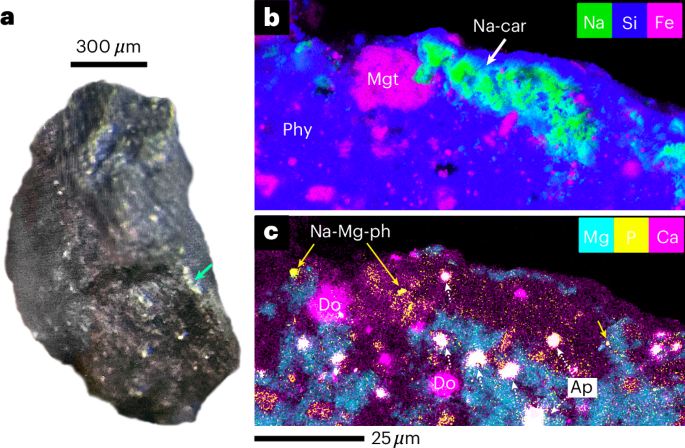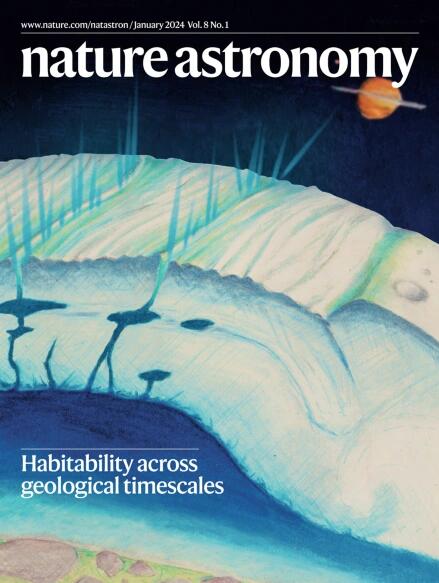龙宫上的碳酸钠是外太阳系高盐度水的证据
IF 12.9
1区 物理与天体物理
Q1 ASTRONOMY & ASTROPHYSICS
引用次数: 0
摘要
小行星中记录的水活动为研究其宜居性提供了一个视角。C型小行星 "龙宫 "的母体发生了水蚀作用,即液态水与矿物的相互作用。然而,"龙宫 "并不是一个湿润的天体,导致液态水消失的过程及其化学环境仍不清楚。我们报告了龙宫样本中碳酸钠、氯化物和硫酸盐的存在,这表明富含盐分的碱性水曾经流经其母体。高浓度的盐水可能是在水蚀作用的最后阶段通过液态水的蒸发或冻结形成的。太阳系中的碳质小行星也可能发生过类似的过程,尽管陨石的陆地风化可能会掩盖盐沉淀的证据。钠盐可能是比较碳质天体中的进化水和矮行星谷神星及木星和土星卫星中的碱性地表下海洋的关键。本文章由计算机程序翻译,如有差异,请以英文原文为准。


Sodium carbonates on Ryugu as evidence of highly saline water in the outer Solar System
Water activity recorded in asteroids offers a perspective on their habitability. Aqueous alteration, namely the interaction of liquid water with minerals, occurred in the parent body of the C-type asteroid Ryugu. However, Ryugu is not a wet body, and the processes that led to the loss of liquid water along with its chemical environment remain unclear. We report the presence of sodium carbonates, chlorides and sulfates in Ryugu samples, which indicate that alkaline, salt-rich water once flowed through its parent body. Highly concentrated brine probably formed through evaporation or freezing of the liquid water in the final stages of aqueous alteration. Similar processes may have occurred in carbonaceous asteroids in the Solar System, although terrestrial weathering of meteorites might obscure evidence of salt precipitation. Sodium salts could be crucial for comparing the evolved water in carbonaceous bodies and alkaline subsurface oceans in the dwarf planet Ceres and the moons of Jupiter and Saturn. Sodium carbonates, chloride and sulfate have been found in samples from asteroid Ryugu. The formation of these compounds from alkaline brines through freezing or evaporation accounts for the loss of liquid water from the parent carbonaceous body.
求助全文
通过发布文献求助,成功后即可免费获取论文全文。
去求助
来源期刊

Nature Astronomy
Physics and Astronomy-Astronomy and Astrophysics
CiteScore
19.50
自引率
2.80%
发文量
252
期刊介绍:
Nature Astronomy, the oldest science, has played a significant role in the history of Nature. Throughout the years, pioneering discoveries such as the first quasar, exoplanet, and understanding of spiral nebulae have been reported in the journal. With the introduction of Nature Astronomy, the field now receives expanded coverage, welcoming research in astronomy, astrophysics, and planetary science. The primary objective is to encourage closer collaboration among researchers in these related areas.
Similar to other journals under the Nature brand, Nature Astronomy boasts a devoted team of professional editors, ensuring fairness and rigorous peer-review processes. The journal maintains high standards in copy-editing and production, ensuring timely publication and editorial independence.
In addition to original research, Nature Astronomy publishes a wide range of content, including Comments, Reviews, News and Views, Features, and Correspondence. This diverse collection covers various disciplines within astronomy and includes contributions from a diverse range of voices.
 求助内容:
求助内容: 应助结果提醒方式:
应助结果提醒方式:


